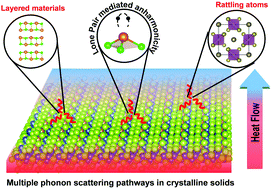Intrinsically ultralow thermal conductive inorganic solids for high thermoelectric performance
Abstract
Thermoelectric materials which can convert heat energy to electricity rely on crystalline inorganic solid state compounds exhibiting low phonon transport (i.e. low thermal conductivity) without much inhibiting the electrical transport. Suppression of phonons traditionally has been carried out via extrinsic pathways, involving formation of point defects, foreign nanostructures, and meso-scale grains, but the incorporation of extrinsic substituents also influences the electrical properties. Crystalline materials with intrinsically low lattice thermal conductivity (κlat) provide an attractive paradigm as it helps in simplifying the complex interrelated thermoelectric parameters and allows us to focus largely on improving the electronic properties. In this feature article, we have discussed the chemical bonding and structural aspects in determining phonon transport through a crystalline material. We have outlined how the inherent material properties like lone pair, bonding anharmonicity, presence of intrinsic rattlers, ferroelectric instability, weak and rigid substructures, etc. influence in effectively suppressing the heat transport. The strategies summarized in this feature article should serve as a general guide to rationally design and predict materials with low κlat for potential thermoelectric applications.

- This article is part of the themed collection: Chemical Communications HOT articles


 Please wait while we load your content...
Please wait while we load your content...